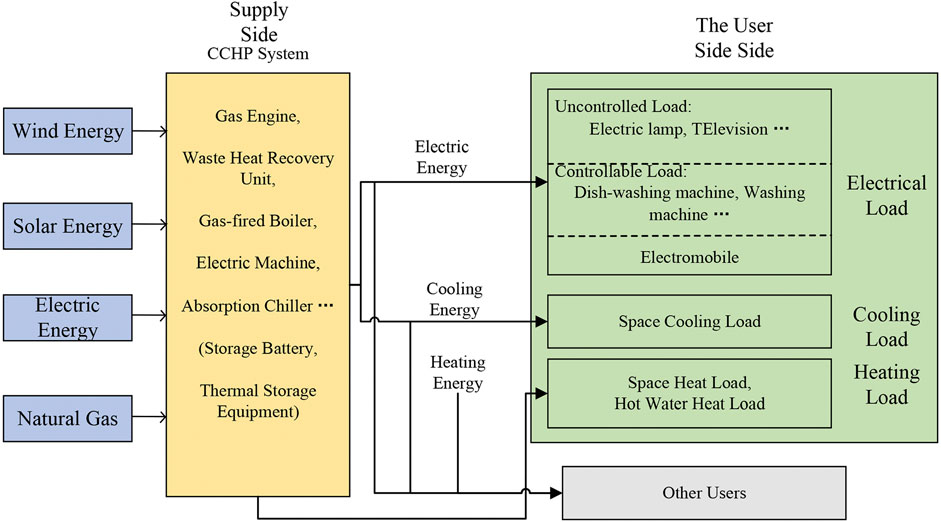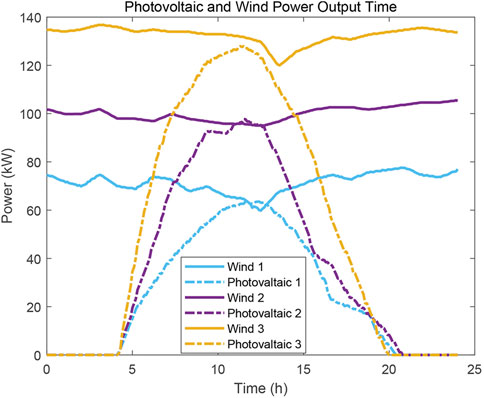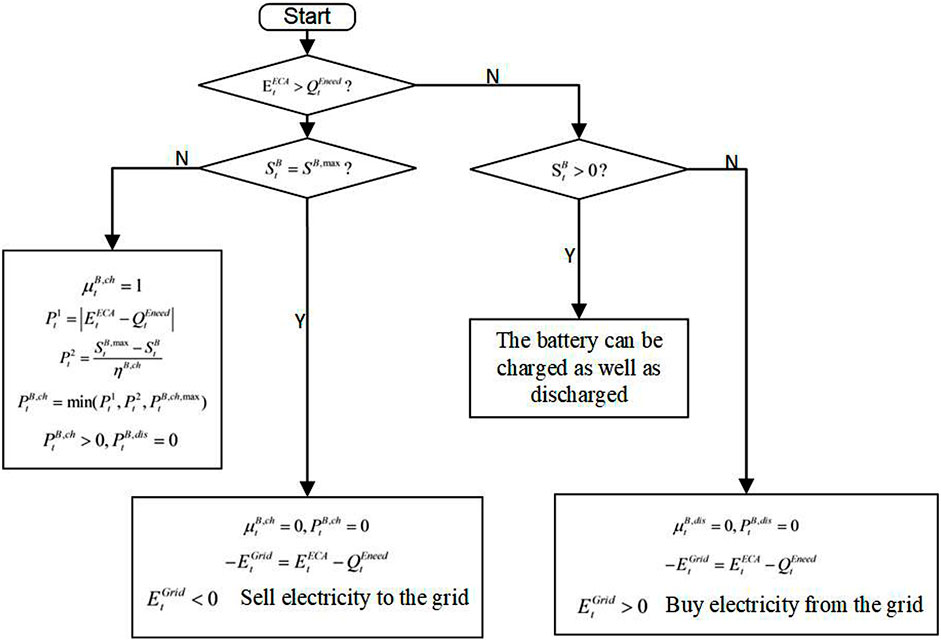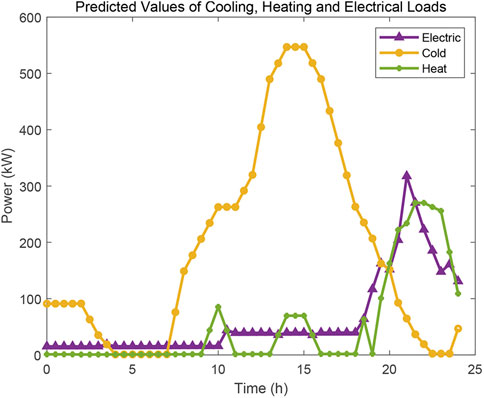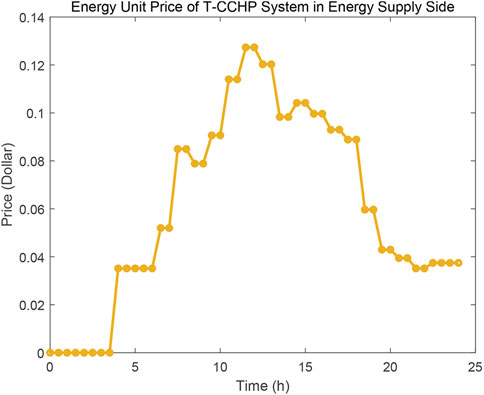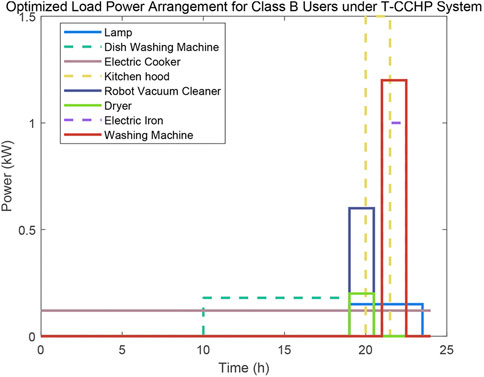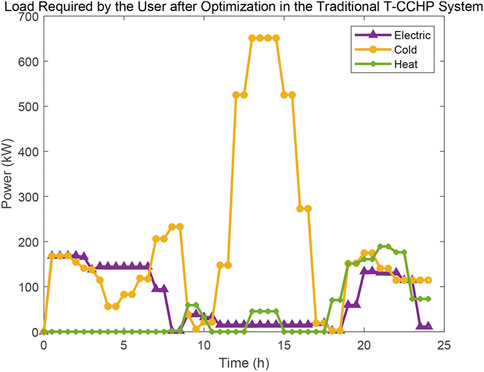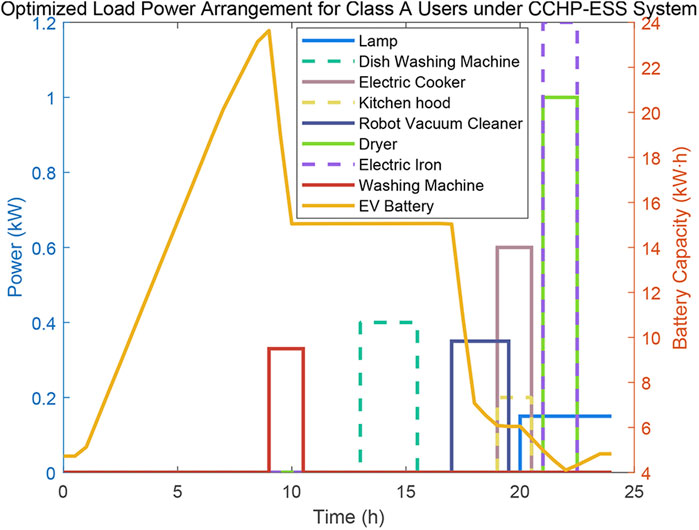Erratum: Intelligent day-ahead optimization scheduling for multi-energy systems
- 1NARI Group (State Grid Electric Power Research Institute) Co., Ltd., Nanjing, Jiangsu, China
- 2NARI Technology Co., Ltd., Nanjing, Jiangsu, China
- 3College of Energy and Electrical Engineering, Hohai University, Nanjing, Jiangsu, China
Concerning energy waste and rational use, this paper studies the optimal scheduling of day-ahead energy supply and the community’s demand with a combined cooling, heating, and power (CCHP) system in summer. From the perspective of bilateral costs and renewable energy use, this paper examines the impact of energy storage systems integrated into cogeneration systems. The Gurobi solver is used to optimize the residential community’s supply and demand sides of the traditional CCHP system (T-CCHP) and the CCHP system with energy storage (CCHP-ESS) under insufficient solar power. Subsequently, two optimal arrangements for energy consumption on the user side under these systems are suggested. In the optimization model, energy storage is added to the T-CCHP system on the energy supply side. On the user side, the energy use scheme is optimized considering the user’s comfort. The innovation point of this study is that the optimization of comprehensive energy in the park involves both supply and demand. The impact of increasing energy storage is discussed on the energy supply side, and the impact of optimization of the energy use plan on costs is discussed on the user side.
1 Introduction
Recently, extensive research has been focusing on environmental pollution challenges because of the global increase in energy consumption, leading to the development of a variety of techniques for “carbon to peak carbon neutralization” (Zhang and Li, 2019). The economics and reliability of power grid operation can be improved more successfully by optimizing the capacity and energy use for combined supply and demand as a whole than by the several unilateral optimization strategies, either on the user or power supply side (Cai et al., 2021). Electric power generation, cooling, and heating are regarded as the new forms of energy supply on the supply side, while they are also regarded as the new forms of energy usage on the demand side (Chen and Lin, 2019). For the combined cooling, heating, and power (CCHP) system, this framework offers a comprehensive multi-energy system formulation that enables the natural multi-energy compatibility to provide the effect of energy cascade utilization (Tang and Gao, 2018). In this way, environmental pollution may decrease, energy consumption costs may decrease, and energy usage efficiency may increase substantially (Wang et al., 2019). Huang and Peng (2021) combined its adaptability to consumer demand with the CCHP system to meet user needs, and on this basis we consider the comfort of users and the flexibility of electricity consumption. On the demand side, a home energy management system can meet consumer demands for comfort and quality of life (Li et al., 2021). Zhu and Lin (2019) mentioned that optimization of the user’s energy-use scheme can improve the user’s power consumption efficiency. Li and Li (2018) proposed that the optimization of energy-use schemes can also optimize the power consumption of household appliances. Simultaneously, the role of household electric vehicles (EVs) in terms of charging and discharging is considered (Wu et al., 2015), and the impact of energy storage links on user-side costs is further examined (Huang and Xu, 2021). The complementary property of wind and solar energy yields efficient cost performance and promotes renewable energy consumption and good application prospects (Gao and Liu, 2021).
The issue of new forms of energy consumption can be effectively mitigated by optimizing the multi-energy system through the use of energy storage systems (ESSs) (Floros and Vlachou, 2005). T-CCHP systems lack energy storage, which results in significant energy loss from wind, light, and other new sources (Ji et al., 2023). In addition, a large amount of high-temperature exhaust gas is produced by gas internal combustion engines during the production of electricity (Dong et al., 2018). High-temperature exhaust gas can be converted into cold load through an absorption refrigerator, and additional cold storage can be integrated for storing extra cold load to prevent energy loss and reduce the impact of renewable energy uncertainties (Li et al., 2023). To improve the power grid’s wind power consumption capacity, Alanne and Saari (2006) have added the heat park of large-capacity ESSs to the energy supply system. Zhang (2022) proved that optimizing the configuration of the ESS can not only solve the issue of new energy consumption but also improve the security and stability of distribution network operation. This paper will further discuss the crucial function of energy storage systems in terms of renewable energy consumption among CCHP systems.
Zeng and Jiang (2018) did not take into account the power generation from alternative energy sources like wind and photovoltaics for the power supply to CCHP systems. Meanwhile, for the types of energy, their complementarity should be considered in solving environmental problems and reducing pollution (Yang and Li, 2023) because it can increase energy absorption capacity while simultaneously increasing the rate of energy use and lowering energy loss (Niu, 2020). Xu and Min (2014) and Wu and Wang (2013) developed a model of a CCHP microgrid supplied by renewable energy and showed that this model significantly contributed to the economy and energy use. On this basis, this paper will examine the high demand for cooling load in summer and the overall energy optimization of electric, heating, and cooling energy.
In recent years, with the increase of the electric power load on the user side, the potential severity of challenges such as the increase of the peak–valley difference of the power load and the detrimental effect on the stability and security of the electric power grid has increased (Li and Zhang, 2022). Fu et al. (2020) suggested that the power load of a household could be considered a controlled load. While some literature have attempted to minimize the total cost by optimizing household electricity consumption on the user side (Lu and Xie, 2019; Zhang and Liu, 2020), there is a lack of information on the classification of the electrical load, and the use of electric vehicles (EVs) by specific consumers is not considered. Therefore, to reduce the total price, this paper attempts to optimize the integrated energy system based on user satisfaction, route scheduling, and the rationality of electricity usage.
The contribution of this paper is to reduce the cost through the comprehensive energy optimization of both the supply and demand sides of the park. On the energy supply side, the impact of energy storage on the CCHP system is explored. On the user side, the impact of energy optimization on the cost is explored. The research shows that optimizing both supply and demand can reduce the cost to the greatest extent. This paper is organized as follows. The structure of the intelligent community and the models of the CCHP system on the energy supply side and the user side are described in Section 1. Section 2 elaborates and optimizes the relevant parameters of the electricity consumption arrangement. Section 3 lists some resulting data on costs. Finally, Section 4 provides the conclusion.
2 Modeling of an integrated energy system for intelligent community
In this section, based on the condition that solar power generation is insufficient, the T-CCHP system including wind power and solar power generation is connected to the energy supply side on the supply side, and the cost impact of new energy consumption and supply and demand on both sides are analyzed by adding energy storage and heat storage (Li and Liu, 2021). The calculation example of solar power generation is used to verify it. On the user side, the load is classified in detail (Luo and Song, 2021), and the characteristics of electric vehicles and household appliances are all optimized. The function of energy storage in terms of both supply and demand costs and renewable energy consumption are comprehensively analyzed.
An intelligent community is divided into the energy supply side and the user side, as shown in Figure 1.
On the user side, the load is divided into cold loads, heat loads, and electric loads, among which the electric load is divided into household electric load and EV load.
This paper is classified as follows.
2.1 CCHP system model on the energy supply side
The total cost of the CCHP system or the sum of the energy purchase cost and the operation and maintenance cost must be minimized while optimizing the energy supply side. The models of the gas-fired internal combustion engine (ICE), waste heat recovery device, absorption refrigerator, electric refrigerator, and gas boiler in the CCHP system are available in Guo (2019), Liu and Chen (2020), and Zhang and Kong (2018). The electric storage and cold storage employed in this study can be found in Li and Li (2018) and Yang and Yu (2017), and the following restriction that the storage power of a battery before and after a scheduling period is equal to 20% of the total capacity is stated. The CCHP system’s energy purchase cost model, which takes into account the purchase and sale of electricity from the power grid, is represented by Formula 1
The CCHP system’s devices are all interconnected, and the Formula 2 equipment’s operating and maintenance cost is represented by
When considering the ESS, the parameters related to the battery and cold storage equipment should also be added.
2.2 Control strategy of renewable energy consumption on the energy supply side
The use of batteries to absorb renewable energy is necessary due to the severe consequences of wind power generation abandonment (Xiong and Liu, 2019). Figure 3 illustrates the absorption control technique. The equilibrium quantity is set as
2.3 User side model
The EV model is shown as Formulas 3, 4
The cooling load at the user side is mainly spatial cooling load, and its model is given as Formula 5
The constraint conditions are
The model of the heat load corresponding to the cooling load is shown as Formula 6
The cold water temperature is assumed to be equal to the outdoor temperature in general. The hot water temperature set by the user with its constraint conditions is
When the supply and demand sides are combined for optimization, the unit price of energy supply is introduced as a bridge as Formula 7
EVs have the characteristics of charge and discharge, but we also need to consider the aging cost of batteries, the cost is shown as Formula 8
The flatness cost of the electrical load is shown as Formula 9
The energy consumption cost on the user side is expressed as Formula 10
The electrical load’s mathematical expression is given as Formula 11
The comprehensive objective function of user-side optimization is the sum of the energy consumption cost, the battery aging cost, and the flatness cost of the electrical load.
3 Results
3.1 Parameter setting
A residential community is chosen as an example to create an optimum operation on a summer day. On a summer day, a residential community is chosen as an example to create an optimum operation. The cooling load considers space cooling demand, while the heating load merely includes hot water heating load. This residential community consists of 100 families, which are divided into two categories, and the differences are shown in Table 1. This study assumes that all EVs and batteries are of the same brand and model, and it principally considers expected common loads.
3.2 Interpretation of the result
Before optimizing the power consumption on the user side, the predicted amount of the cooling and heating electric load on the user side is analyzed to determine the output of each device of the CCHP system. Subsequently, the energy unit price is calculated for optimization, and the output cost of the CCHP system under the customary energy consumption mode is determined by using the time-of-use price for purchasing electricity and gas.
Figure 2 shows several common scene-output situations of summer. We first selected “Wind Power 1” and “Photovoltaic 1” as Scenario 1 to conduct research and analysis of the results and then selected “Wind Power 3” and “Photovoltaic 3” as Scenario 2 to verify the conclusion.
3.2.1 Scenario 1 under T-CCHP
The electricity load consumed includes the household electricity load in Class A and B and the charge load of EVs in Class A requiring heating and cooling loads. Cooling load generally includes space cooling load and water cooling load, but in summer, it mainly refers to space cooling load. Heating load generally includes water heating load and space heating load, and similarly in summer, it mainly refers to water heating load. The predicted amount of the user’s cooling, heating, and electric load is obtained by calculation, as shown in Figure 3.
In scenario 1, Figure 4 shows the apparent characteristics of each kind of load. The peak hour of electric power is between 17:00 and midnight when prices are at their highest. During the day, the cooling load is concentrated, reaching its peak at noon. There is a brief peak in the morning and afternoon, and the heating demand is concentrated between 17:00 and midnight.
The unit price of energy supply is introduced to connect the supply and demand sides for optimal scheduling.
The energy unit price at time t under the T-CCHP system on the energy supply side is shown in Figure 5.
Under the T-CCHP system, the energy consumption scheme of the two classes of users is optimized. After optimization, it is anticipated that user energy consumption will be less concentrated during the peak period of power consumption. Figures 6, 7 display the ideal energy consumption scheme by using the Gurobi solver.
Figure 8 shows the total load demand on the user side after optimization. The user’s power load is concentrated from 00:00 to 08:00 in the morning and 19:00 to midnight, when the unit price of the power supply is not in the peak period, and the optimization result meets the expectation.
3.2.2 Scenario 1 under CCHP-ESS
The energy unit price of the CCHP-ESS has two periods of peak usage in Scenario 1, from 8:00 to 11:00 a.m. and 19:00 to 23:00, as seen in Figure 9. Two trough periods occur from 00:00 to 08:00 in the morning and from 15:00 to 19:00. The unit price of energy supply exhibits a steady state between 11:00 and 15:00 at noon, and the price of energy supply is rather consistent throughout this period.
Peak cutting and valley filling are accomplished in the CCHP system at the user’s side by translating electric and cold energy and introducing batteries and cold storage equipment to absorb additional energy. As a result of the system’s energy supply unit price exhibiting “two peaks and two valleys” characteristics, the user load optimization should preferably avoid peak periods and concentrate on the valley period. The Gurobi solver is also used to optimize the user’s energy consumption time; Figures 10, 11 display the optimization results.
The cooling and heating loads required by the user are calculated, as indicated in Figure 12, based on the optimum power arrangement for Class A and B. Subsequently, on the power supply side, the CCHP system’s output is rescheduled based on the load demand.
The user’s electrical usage is concentrated between 00:00 and 08:00 in the morning and 18:00 and midnight after optimization. This result encompasses both periods with low energy supply unit prices and those with high energy unit prices. However, compared with the predicted value of the user’s load before optimization in Figure 7, the user’s electricity load after optimization is more dispersed and no longer concentrated in the peak value of the unit price. As a result, the optimization’s outcomes match the predictions. Subsequently, the CCHP system considers the optimized power supply scheme on the power supply side, which generates an output for each device. The cost suffered after optimization and the energy unit price are computed at the end.
4 Analysis and discussion
Table 2 shows the comparison of the following six costs for Scenario 1: the energy supply side before and after the optimization of the traditional cogeneration system, the energy supply side costs before and after energy storage system optimization, and the cost before and after ESS optimization on the supply side and the user side.
As shown in Table 2, the user-side cost after optimization is significantly reduced compared with the previous cost. With the ESS, the extent of cost savings is clear. When the energy supply side includes the ESS, the cost of the user side is higher than that of the T-CCHP system before optimization, and the total savings on the user-side cost were 45.54%; the savings on the energy supply-side cost were 31.54%. However, the cost of the energy supply side is significantly lower than that of traditional cogeneration systems. After optimization, both the sides are in an optimal state, and the cost is not only lower than the previous cost but also lower than the cost under the T-CCHP system. For both sides, the cost is further reduced in the CCHP-ESS system.
Scenario 2 is used to verify the advantage of the ESS. Scenario 2 verifies our conclusion. The optimization of energy use arrangements can reduce costs. Adding the ESS to the CCHP systems has the same effect. Therefore, optimizing both supply and demand at the same time can greatly reduce costs. Table 2 shows the optimal scheduling of comprehensive energy in the residential community under the condition that the summer scenery output is sufficient and the impact of whether there is energy storage in the CCHP system on the cost of both supply and demand. Table 2 also shows its impact on the consumption of renewable energy.
Table 2 shows the impact of a CCHP-ESS system in terms of renewable energy consumption; the total savings on the user-side cost was 45.96%, and the savings on the energy supply side cost was 55.70%. The local consumption of wind and solar energy shown in Table 3 illustrates that the function of the ESS is to reduce the overflow phenomenon of wind and solar energy and realize the local consumption of renewable energy. In scenario 1 and scenario 3, the proportion of the local absorption rate of PV and wind power increases by 0.89% and 5.69%, respectively.
A residential community can take advantage of the ESS on the supply and demand sides of the CCHP system in a creative way during the summer. In addition to cutting expenses on both sides, the application of supply-side and user-side optimization schemes can also achieve the novel forms of energy demand, improve energy efficiency, and lessen environmental pollution.
The penetration of renewable energy generation (REG) will increase, necessitating the development of power grid transmission infrastructure and stricter regulations on the use of these new energy sources. According to our result, it is demonstrated that the ESS plays a key role in the emerging types of energy consumption.
5 Conclusion
This paper investigates the integrated energy day optimization scheduling of an intelligent community during summer, encompassing both the supply and demand sides. The supply side includes wind power, photovoltaic power generation, electricity purchase, and natural gas purchase. On the user side, considerations are given to electrical load, thermal load, and cooling load. The Gurobi solver in MATLAB/Yalmip is used to optimize the comprehensive objective function comprising energy purchase cost and operational cost of the system. Furthermore, user-side household appliance optimization takes into account factors such as user comfort, equipment relevance, travel time, and charge–discharge characteristics of electric vehicles. The unit price of energy supply is employed for optimizing both sides of supply and demand. Simulation results are presented accordingly.
1. When the T-CCHP system is adopted on the energy supply side, the cost of the energy supply side is reduced by 1.6%, and the cost of the user side is reduced by 28.05% after optimization in Scenario 1.
2. When the CCHP-ESS system is adopted on the energy supply side, the cost of the energy supply side is reduced by 14.94%, and the cost of the user side is reduced by 35.52% after optimization in Scenario 1. The same result is also verified in Scenario 2. The optimization of energy use arrangements and the addition of the ESS to the CCHP systems can effectively reduce costs. The optimization of both supply and demand can reduce the cost to the greatest extent. In conclusion, optimizing only the energy use scheme and adding only the energy storage system can save costs. By introducing the CCHP-ESS system and optimizing the utilization of the electrical equipment, it can not only greatly reduce the cost of both supply and demand but also improve the consumption rate of new energy, which means that the CCHP-ESS can reduce the peak and valley difference of electricity load and carbon emissions. In the future, we will continue to conduct in-depth research on the optimization of comprehensive energy for intelligent residential areas. The model mentioned in this paper is also applicable to other parks using integrated energy. For example, it can increase the diversity and flexibility of user loads. The application of intelligent air conditioning is more and more extensive, and the adjustable ability is also very strong, which is a good research object.
Data availability statement
The original contributions presented in the study are included in the article/Supplementary Material; further inquiries can be directed to the corresponding authors.
Author contributions
YY: writing–original draft and writing–review and editing. ZZ: investigation and writing–review and editing. XX: methodology and writing–review and editing. PY: methodology and writing–original draft. SL: formal analysis and writing–review and editing.
Funding
The author(s) declare that financial support was received for the research, authorship, and/or publication of this article. This research was funded by the authors who gratefully acknowledge the financial support of the project “Research and application of adjustable resource aggregation technologies based on Internet platform” of NARI-TECH Nanjing Control Systems Ltd. (grant no. 524609220029).
Acknowledgments
First and foremost, I would like to express my gratitude to every author who has worked with me on this paper. Everyone has played to their strengths and made useful suggestions.
Conflict of interest
Authors YY, ZZ, and XX were employed by the NARI Group (State Grid Electric Power Research Institute) Co., Ltd. and NARI Technology Co., Ltd.
The remaining authors declare that the research was conducted in the absence of any commercial or financial relationships that could be construed as a potential conflict of interest.
Publisher’s note
All claims expressed in this article are solely those of the authors and do not necessarily represent those of their affiliated organizations, or those of the publisher, the editors, and the reviewers. Any product that may be evaluated in this article, or claim that may be made by its manufacturer, is not guaranteed or endorsed by the publisher.
References
Alanne, K., and Saari, A. (2006). Distributed energy generation and sustainable development. Renewable& Sustain. Energy Rev. 10 (6), 539–558. doi:10.1016/j.rser.2004.11.004
Cai, Z., Peng, M., and Shen, M. (2021). Day-ahead optimal scheduling of smart integrated energy communities considering demand-side resources. Electr. Power Autom. Equip. 41 (03).
Chen, C., Lin, J., Pan, L., Lee, K., and Sun, L. (2019). Improving simultaneous cooling and power load-following capability for MGT-CCP using coordinated predictive controls. Energies 12, 1180. doi:10.3390/en12061180
Dong, X., Quan, C., and Jiang, T. (2018). Optimal planning of integrated energy systems based on coupled CCHP. Energies 11 (10), 2621. doi:10.3390/en11102621
Floros, N., and Vlachou, A. (2005). Energy demand and energy-related CO2 emissions in Greek manufacturing: assessing the impact of a carbon tax. Energy Econ. 27 (3), 387–413. doi:10.1016/j.eneco.2004.12.006
Fu, Z., Li, X., Zhang, T., et al. (2020). Intelligent optimization strategy of home energy management based on Markov decision process B. Book Title Electric Power Automation Equipment. USA: IEEE.
Gao, Y., Liu, B., He, J., Zhang, K., Liu, L., Jin, L., et al. (2021). Capacity configuration optimization and analysis for multi-energy complementary microgrid in hydropower station considering the renewable energy accommodation. J. Phys. Conf. Ser. 1, 012064. doi:10.1088/1742-6596/2108/1/012064
Guo, T. (2019). Brief analysis of the world energy supply and demand pattern and China's energy cleaning strategy. Energy Energy Conservation 73 (11), 25–28.
Hiroshi, K., Kohei, M., Yoshizawa, S., Fujimoto, Y., Asano, H., Hayashi, Y., et al. (2019). Electric vehicle charge-discharge management for utilization of photovoltaic by coordination between home and grid energy management systems. IEEE Trans. Smart Grid 10 (3), 3186–3197. doi:10.1109/tsg.2018.2820026
Huang, Y., Pang, H., Ding, P., Zhang, B., Lee, K. Y., and Wang, B. (2021). Multi-objective optimization of steam power system under demand uncertainty. IEEE Access 9, 113130–113142. doi:10.1109/ACCESS.2021.3104110
Huang, Y., Xu, J., Gao, S., Lee, K. Y., Wang, D., and Wang, B. (2021). Incomplete information oriented optimal scheduling of multi-energy hub systems with thermal energy storage. J. Energy Storage 42 (October), 103062. doi:10.1016/j.est.2021.103062
Ji, F., Song, J., Liu, Q., et al. (2023). Research on integrated optimization and operating characteristics of CCHP system for coupled wind storage and heat pump. Therm. Power Gener. 52 (10), 103–112.
Li, G., Li, F., et al. (2018). Economic dispatch of microgrid with energy storage under different price policies. Electr. Power 51 (02).
Li, H., Liu, Y., et al. (2021). Residential demand response scheduling optimization and simulation based on an improved PSO algorithm. J. Syst. Simul. 33 (08).
Li, Y., Zhang, J., Wu, X., Shen, J., and Lee, K. Y. (2022). Optimal design of combined cooling, heating and power multi-energy system based on load tracking performance evaluation of adjustable equipment. Appl. Therm. Eng. 211, 118423. doi:10.1016/j.applthermaleng.2022.118423
Li, Z., Xu, Y., Feng, X., and Wu, Q. (2021). Optimal stochastic deployment of heterogeneous energy storage in a residential multienergy microgrid with demand-side management. IEEE Trans. Industrial Inf. 17 (2), 991–1004. doi:10.1109/TII.2020.2971227
Li, Z., Xu, Y., Wang, P., and Xiao, G. (2023). Restoration of Multi Energy Distribution Systems with Joint District Network Recon Figuration by a Distributed Stochastic Programming Approach. IEEE Transactions on Smart Grid, doi:10.1109/TSG.2023.3317780
Liu, J., Chen, J., et al. (2020). Energy management and optimization of multi-energy grid based on deep reinforcement learning. Power Syst. Technol. 4 (10).
Lu, H., Xie, K., et al. (2019). Reliability assessment of multi-energy system considering multi-storage and integrated demand response. Electr. Power Autom. Equip. 39 (8), 72–78.
Luo, X., Song, Y., et al. (2021). Research on optimal allocation of energy storage of integrated energy system considering wind power uncertainty. Northeast Electr. Power Technol. 42 (12).
Niu, Q. (2020). Research on collaborative optimization planning method of electric-gas coupling system. Shanghai: Shanghai University of Engineering Science.
Tang, B., Gao, G., Xiangwu, X., and Xiu, Y. (2018). Integrated energy system configuration optimization for multi-zone heat-supply network interaction. Energies 11 (11), 3052. doi:10.3390/en11113052
Wang, Y., Wu, J., and Mao, X. (2019). Economic distribution model of cooling, heating and power energy in multi-energy supply system based on stochastic dynamic programming. Electr. Power Autom. Equip. 39 (6), 21–26.
Wu, F. F., Varaiya, P. P., and Hui, R. S. Y. (2015). Smart grids with intelligent periphery: an architecture for the energy Internet. Engineering 1 (04), 436–446. doi:10.15302/j-eng-2015111
Wu, X., Wang, X., et al. (2013). Economic operation of microgrid with combined heat and power system. Electr. Power Autom. Equip. 33 (8), 1–6.
Xiong, W., Liu, Y., et al. (2019). Optimal configuration of multi-energy storage in regional integrated energy system considering multi-energy complementation. Electr. Power Autom. Equip. 39 (1), 118–126.
Xu, F., Min, Y., et al. (2014). Combined electricity-heat operation system containing large capacity thermal energy storage. Proc. CSEE 34 (29), 5063–5072.
Yang, Y., Li, Z., Mandapaka, P. V., and Lo, E. Y. (2023). Risk-averse restoration of coupled power and water systems with small pumped-hydro storage and stochastic rooftop renewables. Appl. Energy 339, 120953–122619. doi:10.1016/j.apenergy.2023.120953
Yang, Y., Yu, J., et al. (2017). Optimal load leveling dispatch of CCHP incorporating photovoltaic and storage. Automation Electr. Power Syst. 41 (6), 6–12.
Zeng, B., Jiang, W., et al. (2018). Optimal load dispatching method based on chance-constrained programming for household electrical equipment. Electr. Power Autom. Equip. 38 (9), 27–33.
Zhang, H. (2022). Optimized configuration method of distributed energy storage for improving renewable energy accommodation in distribution network. Eng. Des. 41 (03).
Zhang, L., Li, F., Sun, B., and Zhang, C. (2019). Integrated optimization design of combined cooling, heating, and power system coupled with solar and biomass energy. Energies 12 (4), 687. doi:10.3390/en12040687
Zhang, T., Liu, L., et al. (2020). Energy system scheduling considering demand response and wind power uncertainty. J. Zhejiang Univ. Eng. Sci. 54 (8), 1562–1571.
Zhang, Y., Kong, X., et al. (2018). Multi-time scale home energy management strategy based on electricity demand response. Power Syst. Technol. 42 (6), 1811–1819.
Zhu, J., Lin, Y., et al. (2019). Optimal household appliances scheduling of multiple smart homes using an improved cooperative algorithm. Energy 01 (25).
Nomenclature
Keywords: heat and cold power supply system, multi-energy system, day-ahead energy scheduling, combined cooling, heating, and power (CCHP), intelligent community
Citation: Yufeng Y, Zhicheng Z, Xubing X, Yaxin P and Linjun S (2024) Intelligent day-ahead optimization scheduling for multi-energy systems. Front. Energy Res. 11:1349194. doi: 10.3389/fenrg.2023.1349194
Received: 04 December 2023; Accepted: 28 December 2023;
Published: 24 January 2024.
Edited by:
Zhengmao Li, Aalto University, FinlandReviewed by:
Yu Huang, Nanjing University of Posts and Telecommunications, ChinaYixing Ding, Nanjing Tech University, China
Copyright © 2024 Yufeng, Zhicheng, Xubing, Yaxin and Linjun. This is an open-access article distributed under the terms of the Creative Commons Attribution License (CC BY). The use, distribution or reproduction in other forums is permitted, provided the original author(s) and the copyright owner(s) are credited and that the original publication in this journal is cited, in accordance with accepted academic practice. No use, distribution or reproduction is permitted which does not comply with these terms.
*Correspondence: Yang Yufeng, eWFuZ3l1ZmVuZ0BzZ2Vwcmkuc2djYy5jb20uY24=; Xiao Xubing, eGlhb3h1YmluZ0BzZ2Vwcmkuc2djYy5jb20uY24=
 Yang Yufeng1,2*
Yang Yufeng1,2* Pang Yaxin
Pang Yaxin Shi Linjun
Shi Linjun